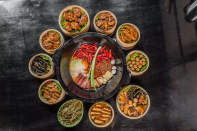Truth matters. Community matters. Your support makes both possible. LAist is one of the few places where news remains independent and free from political and corporate influence. Stand up for truth and for LAist. Make your year-end tax-deductible gift now.
How Umami Overcame Discrimination And Took Its Place As The 5th Taste

What makes a meal delicious? Often, the answer might be umami. The Japanese word means "delicious taste," and refers specifically to a savory, meaty flavor often found in fish broths, mushrooms, cheese and tomato sauce.
Umami is now considered the fifth primary taste — next to sweet, sour, bitter and salty, but as I discovered, umami has a character and history all its own.
Having Japanese immigrant parents meant I grew up eating foods steeped in umami: Soy sauce, miso paste, and dashi, a broth made from seaweed, shiitake mushrooms, or shaved bonito flakes, made from dried tuna. Those ingredients in particular are cornerstones of Japanese cuisine, so "umami" was a dinner-table word in my family, long before it entered the American lexicon.
I didn't know what umami was, exactly; I thought of it like a magical elixir, the culinary hero pumping up food's "yum factor." It's savory and salty, like a ramen made of long-simmered bone broth. It can also have tang, like marinara sauce sprinkled with Parmesan, or ranch-flavored tortilla chips. It seemed so central to describing deliciousness itself, it seemed odd that English would have no equivalent word.
Then again, I get why umami evades description. Almost everything about it is mysterious and complex — from how we perceive its taste, to its history and its fight for legitimacy.
A sense of mystery
Oxford psychologist Charles Spence, who studies taste perception, says a lot of that probably goes backs to the unusual way we sense umami. "It only comes alive and it becomes delicious when it's combined with an aroma," he explains. That's not true of other tastes: "Sweetness is a sweet whether or not you can smell anything; same for salty, same for bitter."
On its own, umami doesn't taste strong or particularly good. But, says Spence, when combined with other foods, umami punches up flavors of protein and salt, while also weaving in other tastes, like sour and sweet. "All the tastes interact with one another, sometimes suppressing, sometimes enhancing the other tastes."
This complexity of umami's might also explain why it wasn't isolated and recognized as a taste until relatively recently in Western culture.
It was a Japanese man, inspired by his wife's rich kelp broth, who isolated the chemical compound glutamate from seaweed in 1908. Chemist Kikunae Ikeda, identified it as the source of this peculiar savory taste, and called it "umami." (There are two other compounds – guanylate, and inosinate – that researchers also associated with umami.)
But it would take nearly a century — and the discovery of glutamate receptors on our tongues two decades ago — before Western cultures accepted umami as a primary taste.
That resistance, Spence says, is rooted in discrimination.
Legacy of discrimination
"[There are] racist undertones that it came from the East," he says, which meant Western scientists and chefs were slow to embrace it. He says that legacy still powerfully shapes consumer perception today.
Soon after its discovery, a Japanese company started marketing a salt-like additive that delivered an umami punch, monosodium glutamate, or the notorious MSG. That notoriety stems from a persistent, 50-year-old myth that MSG used in Chinese restaurants causes headaches.
"It's a zombie myth that will not die," says John Hayes, a behavioral food scientist at Penn State.
Hayes says many people still don't realize that, despite its borrowed Japanese name, umami exists in all cuisines.
Pepperoni pizza: It's just a huge umami bomb. There's umami from the cheese, umami from the tomatoes, there's umami from the cured meats.

"Pepperoni pizza: It's just a huge umami bomb," Hayes points out. "There's umami from the cheese, umami from the tomatoes, there's umami from the cured meats. If 'Chinese restaurant syndrome' were real, then that pepperoni pizza should give you a giant headache as well."
The irony of that persistent myth is that umami can actually make food healthier — and more satisfying. Through its mysterious interactions with other flavors; the savory quality of umami can make things taste richer, without adding sodium or fat, for example.
Spence says he's been advocating for greater use of MSG in airline food, for example, which is typically oversalted because flight conditions tend to dull other tastes. "[Umami] is the one taste that stands up to altitude better than all the others."
Flavor chemist Arielle Johnson also notes umami-rich foods tend to take time to prepare; they're often fermented, like kimchi, or slow cooked, like a bone broth. "Umami is a particularly good example of careful mixing and tending and aging and shepherding of ingredients until they become something that is delicious to us," Johnson says.
That reminds me of my childhood notions about umami. It does, indeed, possess mysterious qualities that are hard to describe, even among scientists. And umami, in many ways, reflects the love and deliciousness that goes into a dish. I was not wrong.
Umami also has another profound attribute I had not appreciated as a child: It went unrecognized and unappreciated by Western culture, but eventually overcame that bias and discrimination by simply demonstrating that it has universal, human appeal.
Copyright 2024 NPR. To see more, visit npr.org.










